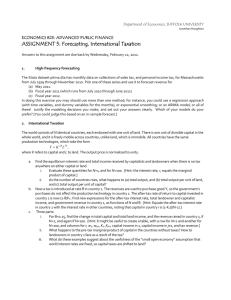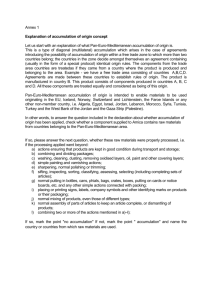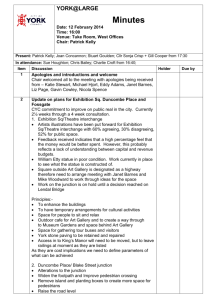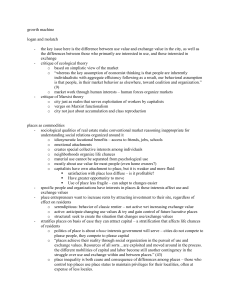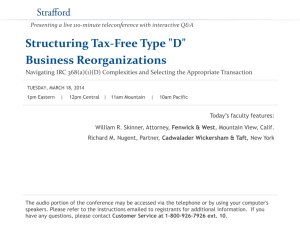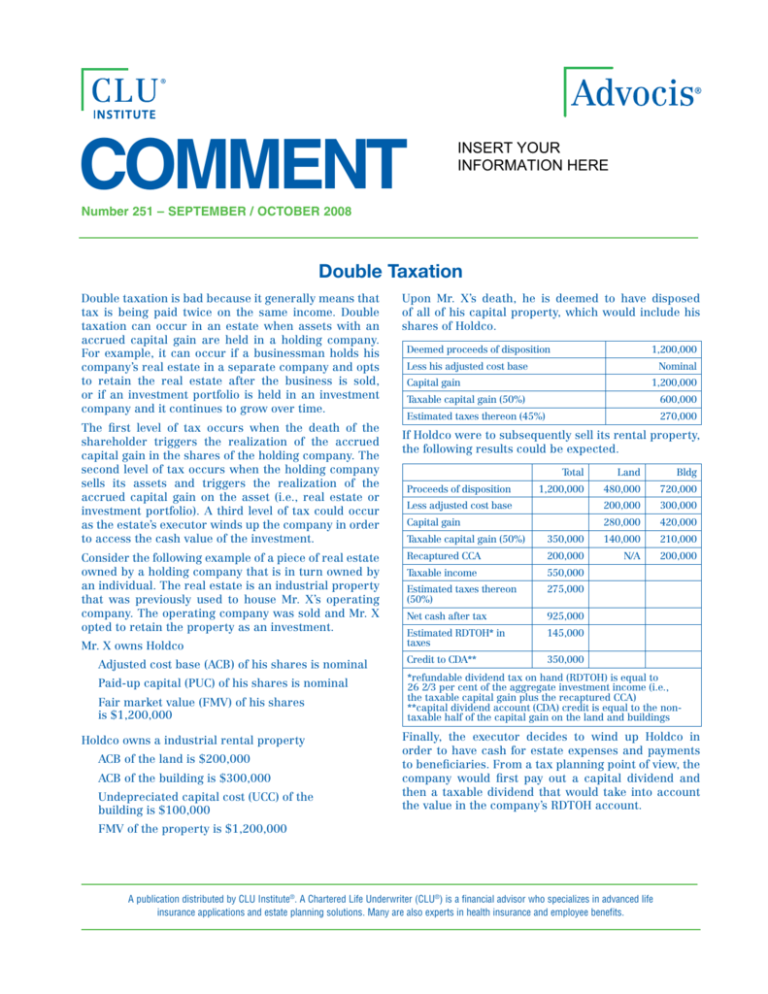
COMMENT
INSERT YOUR
INFORMATION HERE
Number 251 – SEPTEMBER / OCTOBER 2008
Double Taxation
Double taxation is bad because it generally means that
tax is being paid twice on the same income. Double
taxation can occur in an estate when assets with an
accrued capital gain are held in a holding company.
For example, it can occur if a businessman holds his
company’s real estate in a separate company and opts
to retain the real estate after the business is sold,
or if an investment portfolio is held in an investment
company and it continues to grow over time.
The first level of tax occurs when the death of the
shareholder triggers the realization of the accrued
capital gain in the shares of the holding company. The
second level of tax occurs when the holding company
sells its assets and triggers the realization of the
accrued capital gain on the asset (i.e., real estate or
investment portfolio). A third level of tax could occur
as the estate’s executor winds up the company in order
to access the cash value of the investment.
Upon Mr. X’s death, he is deemed to have disposed
of all of his capital property, which would include his
shares of Holdco.
Deemed proceeds of disposition
1,200,000
Less his adjusted cost base
Nominal
Capital gain
1,200,000
Taxable capital gain (50%)
600,000
Estimated taxes thereon (45%)
270,000
If Holdco were to subsequently sell its rental property,
the following results could be expected.
Total
Proceeds of disposition
1,200,000
Land
Bldg
480,000
720,000
Less adjusted cost base
200,000
300,000
Capital gain
280,000
420,000
Taxable capital gain (50%)
350,000
140,000
210,000
Recaptured CCA
200,000
N/A
200,000
Taxable income
550,000
Estimated taxes thereon
(50%)
275,000
Net cash after tax
925,000
Estimated RDTOH* in
taxes
145,000
Adjusted cost base (ACB) of his shares is nominal
Credit to CDA**
350,000
Paid-up capital (PUC) of his shares is nominal
Fair market value (FMV) of his shares
is $1,200,000
*refundable dividend tax on hand (RDTOH) is equal to
26 2/3 per cent of the aggregate investment income (i.e.,
the taxable capital gain plus the recaptured CCA)
**capital dividend account (CDA) credit is equal to the nontaxable half of the capital gain on the land and buildings
Consider the following example of a piece of real estate
owned by a holding company that is in turn owned by
an individual. The real estate is an industrial property
that was previously used to house Mr. X’s operating
company. The operating company was sold and Mr. X
opted to retain the property as an investment.
Mr. X owns Holdco
Holdco owns a industrial rental property
ACB of the land is $200,000
ACB of the building is $300,000
Undepreciated capital cost (UCC) of the
building is $100,000
FMV of the property is $1,200,000
Finally, the executor decides to wind up Holdco in
order to have cash for estate expenses and payments
to beneficiaries. From a tax planning point of view, the
company would first pay out a capital dividend and
then a taxable dividend that would take into account
the value in the company’s RDTOH account.
A publication distributed by CLU Institute®. A Chartered Life Underwriter (CLU®) is a financial advisor who specializes in advanced life
insurance applications and estate planning solutions. Many are also experts in health insurance and employee benefits.
COMMENT
Cash position of Holdco
925,000
Capital dividend
350,000
New cash position
575,000
Maximum taxable dividend
720,000
Estimated taxes thereon (30%)
216,000
Cash position of executor*
854,000
Less taxes triggered in the estate**
270,000
Final cash position
584,000
As a percentage of FMV
48.7%
Effective tax rate
51.3%
*equal to the capital dividend of $350,000 plus the net
cash on the taxable dividend of $504,000 ($720,000 minus
$216,000)
**on the deemed disposition on death (see above)
The above example demonstrates that over 50 per
cent could be lost in taxes because of the double tax
problem. Here, of the $1,200,000 in fair market value
proceeds, only $584,000 remains after tax.
However, careful post-mortem planning can significantly
reduce the impact of the double taxation problem
described above. The strategy would involve utilizing
the executor’s high ACB in the shares of Holdco, the
creation of a new holding company (Newco), the windup
of Holdco into Newco and finally a tax election to bump
the ACB of Holdco’s assets as they pass to Newco. This
is a fairly complicated tax transaction and should only
be completed by competent tax professionals.
That said, the following would be the results.
1. The executor would transfer the shares of Holdco
into Newco taking back a promissory note for
$1,200,000 being the amount equal to the ACB of
the shares of Holdco and some common shares that
would have nominal value. At this point, the estate
would own Newco and Newco would own Holdco.
3. After the windup of Holdco into Newco, Newco would
sell the assets and, because of the bump in the ACB,
it would be able to avoid the realization of the capital
gain. While the recapture would still trigger some
taxes, the overall tax liability would be reduced.
4. The after-tax proceeds from the sale of the real
estate would be used to repay the promissory note
established in step one.
Newco should be able to sell the real estate with the
following income tax results:
Total
Proceeds of disposition
1,200,000
Land
Bldg
480,000
720,000
480,000
720,000
Capital gain
Zero
Zero
Taxable capital gain
Zero
Zero
N/A
200,000
Less adjusted cost base
Recaptured CCA
Taxable income
200,000
Estimated taxes thereon
(50%)
100,000
Net cash after tax
Estimated RDTOH in taxes
Credit to CDA
1,100,000
53,000
Zero
The net cash available to the executor after this postmortem tax planning strategy would be $1,100,000 less
$270,000 or a net after-tax cash position of $830,000,
which represents 69.2 per cent for an effective tax load
of 30.8 per cent. Planning allowed a tax reduction of
$246,000.
Planning is available to those who are aware of issues
in their circumstances. It is important to involve
insurance, tax and legal advisors to ensure the best
possible tax results in complex situations.
I/R 7401.00
2. Holdco would be wound up into Newco. The windup
of Holdco into Newco allows the opportunity for an
election that could bump the ACB of the assets held
by Holdco that are now being transferred to Newco.
Income Splitting
The usual objective of income splitting is to lower
the overall tax load of the family. Most commonly,
income can be split between spouses or between
parents and children. This article will deal with
income splitting with one’s spouse. It should be noted
that for income tax purposes, a “spouse” includes a
common-law partner, including a same-sex partner.
on property that was gifted from the other spouse or
transferred at an amount less than fair market value,
all of the investment income and capital gain would be
attributed back to the contributing spouse and taxed in
his or her hands.
The trouble with trying to minimize tax through
income splitting is that the Income Tax Act contains
a tremendous number of anti-avoidance measures
to minimize a taxpayer’s ability to income split and
therefore lower his or her overall income tax liability.
This rule would also apply to investment income and
capital gains earned on property that was purchased
with interest-free or low interest loans (with one
exception, noted in the second point below) from the
first spouse. It should be noted that even if the second
spouse repays the interest-free loan from other property,
the attribution rules would continue to apply.
Under the attribution rules of the Act, income on
property transferred to a non-arm’s-length person can
be attributed back to the transferor. For example, if
one spouse earns investment income or a capital gain
The spousal attribution rules will continue to apply until
the gift or loan is reversed, the death of one spouse,
a divorce of the spouses or until 90 days following a
separation of the common-law partners.
Number 251 – September / October 2008
COMMENT
Careful planning will allow the spouses to split income
by following one or more of the following strategies.
1) Investment income and capital gains can be split
between spouses if the income/gain is earned on
property that has been transferred at fair market
value. This would include property that is sold at
fair market value from one spouse to the other. This
could create a taxable capital gain in the year of the
transfer, however.
2) One spouse could also lend money to the other in
order to facilitate the purchase of an investment.
Loans between spouses require that interest be
charged at a minimum rate equal to the prescribed
rate in effect under the tax legislation when the loan
was established. In addition, interest must be paid
annually by at least 30 days following the year-end.
does not attract attribution. This strategy requires
keeping meticulous records of the attributed income
and separating future income earned on that
attributed income.
4) Money can be lent from one spouse to the other to
fund a private business. In such a case, the income
generated from the private business is not subject
to attribution. Of course, there is risk of loss of the
funds in this scenario.
5) Pension income can be split between spouses under
the rules introduced in 2007.
Income splitting, if done with care and expert advice, can
lower the overall income tax load of the family and leave
more cash for lifestyle needs or enhanced accumulation.
I/R 2500.13
3) So-called “second generation” income, or income
earned on the reinvested income from the asset,
RCA, Dead Or Alive?
Retirement compensation arrangements (RCAs) were
introduced into the Income Tax Act as an anti-avoidance
measure in 1986. At that time, the Department of Finance
needed a measure in the Act to prevent not-for-profit,
charitable, municipal, sport and other organizations
that were not concerned about tax deductions from
setting aside large amounts of executive income into
deferred plans on behalf of their executives.
The anti-avoidance measure was a special flat tax of
50 per cent on contributions to unregistered retirement
plans and on realized investment income in those
plans. That tax rate was a little bit higher than the top
marginal tax brackets in all of the provinces and higher
than most corporate tax rates for those companies and
organizations that were subject to tax. Since 1986, the
top marginal brackets have risen and declined, resulting
in some advisors offering blanket advice on whether
RCAs are “dead or alive” depending on the taxpayer’s
top marginal tax bracket.
The truth of the matter is that sound planning depends
on the specific facts of each situation and the taxpayer’s
objectives.
A second truth is that planning should not begin with
numbers, but rather an overview of the alternatives
from a logical and common sense point of view that
takes into account the facts of the situation and the
taxpayer’s objectives. Then, numbers can play a role in
measuring the alternatives.
Consider the situation of an individual who owns a small
business corporation. The individual draws out enough
income to meet his needs and any additional income
that he withdraws would be taxed at the top marginal
tax rate. He decides that he wants to set aside some
current income for his future retirement needs. Assume
that he has already maximized his contributions to
registered pension and retirement savings plans. He is
considering leaving the funds in his company, drawing
out the funds and investing personally or utilizing an
RCA and accumulating the after-tax amounts.
The analysis will depend on a great number of factors,
such as the corporation’s tax rates on active income and
on passive income, the individual’s current marginal tax
bracket and his estimated future marginal tax bracket
as well as his average tax rate. Costs associated with the
various options must also be accounted for. For example,
there are setup and administration costs associated
with an RCA. In addition, there are a great number of
variables that defy easy measurement, such as creditor
protection of the funds, access to the capital gains
exemption, extreme plans like moving offshore, etc.
Current income accumulated in the corporation would
first be subject to corporate tax, which could be assumed
to be based on the small business rate. However,
the investment income realized on the investment
accumulation inside the company would be subject
to the top corporate rate plus an additional tax called
additional refundable tax. A portion of the corporate tax
would be refundable but only when the company pays
taxable dividends to its shareholders, thus reducing the
funds available within the corporation for investment.
As noted above, one of the non-measurable issues is
creditor sheltering. Funds accumulated in a company
would be subject to claims by the company’s creditors.
Current income could be paid out of the company to
the shareholder, who would then be subject to tax on
this extra income. Because income to fund his current
lifestyle needs will have used up the lower marginal
tax brackets, any extra income would be subject to
tax at the top marginal tax rate as assumed above. By
drawing the income out of the company, the tax liability
is immediately triggered, leaving only the after-tax
balance for investment. While creditor protection has
not been completely avoided, it has been limited to the
shareholder’s own creditors and potentially protected
from the company’s creditors.
Number 251 – September / October 2008
COMMENT
Alternatively, some of the company’s current income
could be contributed to an RCA to be held and
accumulated to subsidize the shareholder’s eventual
retirement income. (Note that the arrangement must
be carefully structured to ensure its desired treatment
as an RCA.) As already noted, an RCA is subject to a flat
50 per cent tax on contributions and realized income,
but this tax is refundable when the RCA trust makes
distributions to its beneficiary. There are no income
tax consequences to the individual when the funds are
contributed to the RCA, rather the individual will be
taxed when the funds are distributed out of the RCA.
The advantage of this structure is that the shareholder’s
ultimate taxation of the income is deferred into the
future. This can be an advantage if the tax cost on
income is lower in the future than today.
Accumulation Analysis
High Province
Top marginal tax bracket
Pre-tax corporate income
to be saved each year, at an
assumed rate of 5%
Low Province
48.25%
39.00%
100,000
100,000
RCA Accumulation
High Province
Low Province
Refundable withholding taxes
paid
50,000
50,000
After-tax amount to be saved
50,000
50,000
After-tax value after one year
51,250
51,250
Value of the refundable taxes
51,250
51,250
After-tax value after 10 years
574,173
574,173
Value of the refundable taxes
574,173
574,173
What remains to be analyzed is whether the individual’s
marginal tax bracket or his average tax rate at
retirement should be taken into account when analyzing
the alternatives. The marginal tax bracket may make
sense if the individual realizes a great deal of income
and any new income would be taxed at the top rate.
The average tax rate may make sense if the individual’s
total income hovers around the top marginal bracket
and new income would be received, essentially, at a
blended rate.
Analysis of Alternatives
Personal Accumulation
Personal taxes paid
48,250
39,000
After-tax amount to be saved
51,750
61,000
After-tax value after one year
53,089
62,861
After-tax value after 10 years
597,170
722,287
Corporate tax rate for active
income
35.50%
29.50%
Corporate tax rate for passive
income
50.67%
44.67%
Corporate taxes paid
35,500
29,500
After-tax amount to be saved
64,500
70,500
After-tax value after one year
66,091
72,450
860
940
After-tax value after 10 years
739,304
821,686
Value of the RDTOH account
50,979
56,238
Corporate Accumulation
Value of the RDTOH account
High Province
Low Province
Personal Accumulation
597,170
722,287
Corporate Accumulation
790,283
877,924
1,148,347
1,148,347
RCA Accumulation
The amounts of personal accumulation shown are net
of personal income taxes paid. Amounts of corporate
accumulation distributed to the shareholder will be
taxed as dividends. Amounts paid from an RCA to an
individual are fully subject to tax.
Corporate accumulation is better than personal
accumulation if the individual’s effective tax rate on
dividend income is less than 24 per cent for a high-taxed
province or 18 per cent for a low-taxed province. An
RCA accumulation is better than personal accumulation
if the individual’s tax on regular income is less than 48
per cent for a high-tax province or 37 per cent for a
low-tax province. The answer is not simple, but one of
understanding the options available and how they could
change over time or how options may vary if there is an
adjustment to the assumptions.
Planning should not be subject to generic blanket rules
nor be led by numbers. A retirement compensation
arrangement may make sense in the right situation.
I/R 6401.00
Subscribe to CLU Comment today at
www.advocis.ca.
Contributors to this issue of Comment:
James W. Kraft, ca, mtax, tep, cfp, clu, ch.f.c.
Deborah Kraft, mtax, tep, cfp, clu, ch.f.c.
Published by:
CLU Institute
390 Queens Quay West, Suite 209,
Toronto, Ontario M5V 3A2
T: 416.444.5251 or 1.800.563.5822
F: 416.444.8031
www.cluinstitute.ca • info@cluinstitute.ca
Number 251 – September / October 2008
This commentary is published by CLU Institute in consultation with an editorial board comprised of
recognized authorities in the fields of law, life insurance and estate administration.
CLU Institute is the professional organization that administers and promotes the Chartered Life
Underwriter of Canada designation.
The articles in CLU Comment are not intended to provide legal, accounting or other advice in
individual circumstances. Seek professional assistance before acting upon information included in
this publication.
Advocis®, CLU® and APA™ are trademarks of The Financial Advisors Association of Canada.
Publication Agreement # 40069004
Copyright 2008
ISSN 0382-7038
All Rights Reserved

